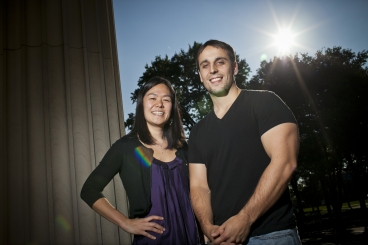A new study that appeared in the journal Solar Energy is a transitional shift from the conventional theory that sunlight will produce either thermal energy or electric energy. The research study shows that both heat and power can be produced simultaneously.
 Evelyn Wang, left, associate professor of mechanical engineering, and graduate student Nenad Miljkovic. Credit: Dominick Reuter
Evelyn Wang, left, associate professor of mechanical engineering, and graduate student Nenad Miljkovic. Credit: Dominick Reuter
The study by Evelyn Wang, who works at MIT as associate professor of mechanical engineering, and Nenad Milijkovic suggests the use of thermoelectric principles or equipment that can generate electric current using a temperature gradient formed in a concentrated solar thermal arrangement also known as parabolic troughs. Such an arrangement deploys lengthy and curved mirrors also known as troughs to concentrate the sun rays over a glass tube that runs parallel to the centerline of the curved mirrors. A liquid is pumped and passed through the tube, gets heated by the sun’s energy, which in turn can be used to generate steam to run the turbines or be used directly for space heating purposes. The embedded device known as a thermosiphon attracts the heat from the cold sections of the thermoelectric equipment, thus ensuring that the temperature gradient is maintained.
The system proposed by the researchers will modify the central tube arrangement of a parabolic trough into a number of concentric tubes. A narrow tube within the first tube will hold the thermoelectric material with an even slimmer tube at the middle of the equipment containing the thermosiphon inertly channelizing the heat from the cold side of the thermoelectric device, hence there is no need to pump cooling fluid as required in a traditional parabolic curved mirror system. The heat transmitted by the thermosiphon is then utilized for heating water for space heating, hot water or industrial process.
According to Wang, thermoelectrics provide a range of advantages over photovoltaics that includes enabling functioning at hot conditions in order to produce higher levels of temperature gradient and yet cost-effective when compared to the normal PV modules. Also the thermosiphon draws heat the way a siphon draws liquid and is a passive method used for heat transfer. The researchers utilized a computer model to identify the optimal coordinated sequences of the available materials for use in the thermosiphon and thermoelectric devices. The simulated model enables testing of a range of operating conditions to design an efficient system. The research work, which forms a segment of the MIT S3TEC Center has received a grant from the Department of Energy through its Energy Frontier Research Center.